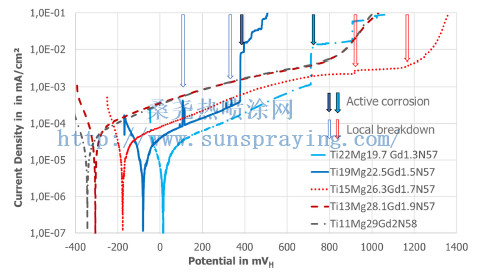The typical PVD-process related growth defects, e.g. pinholes or macroparticles (“droplets”), can act as paths where the corrosive medium penetrates down to the less noble substrate material. As a consequence of this, there is a high anodic current density due to the unfavourable electrode area ratios causing a rapid anodic dissolution of the substrate material. The difference between the corrosion potentials between the layer and the substrate determines the driving force for corrosion. In general, binary, ternary or higher-component nitride layers based on typical hard coatings like TiN or CrN exhibit more noble properties than the low-alloyed QT steel substrates, thus accelerating corrosion kinetics by high anodic current densities at defects. Insulating coating materials such as Al2O3 or Si3N4 mitigate this problem. However, these layers are brittle and require special coating technologies, which are not common for job coating. Thick DLC-based coatings (> 20 μm) offer corrosion protection comparable to that of electroplated chrome, but with a hardness of only about 1000 HV these coatings are significantly softer than conventional DLC and require steels with a tempering temperature > 400 °C. Due to their low thickness, conventional DLC coatings are not suitable for the corrosion protection of low-alloy steels.In order to improve PVD coatings for applications under corrosive conditions, recent research activities have focused on optimizing the coating architecture as well as to reduce defects. By establishing multilayer systems, growth defects within a layer should not reach from the substrate to the surface due to the laminate-like structure. HiPIMS (High Power Impulse Magnetron Sputtering) could also produce denser and more homogeneous coatings with good adhesion and improved coating properties in comparison to conventional direct current magnetron sputtering (DC-MS). An improvement of the coating properties can also be achieved by a nanostructuring, e.g. by the addition of Si in order to increase the nucleus density and to limit crystal growth. Despite some successes in the laboratory scale there is no reliable PVD coating system available today, which shows a similar wear and corrosion performance as electroplated Cr. The main problem is the scaling effect between laboratory research and industrial application. In the laboratory scale, polished (“ideal”) specimens are common, which often deviate from the usual technical surface conditions. In most cases, even one critical pinhole in the coating is sufficient to cause corrosive failure of the component during operation. Today, in applications that are subject to simultaneous tribological and corrosive stress, typically 15 μm to 30 μm thick electroplated (EP) hard chrome coatings are often used. However, with the licensing procedures required by the REACH Regulation for chromium (VI)-processing electroplating plants since 2017, the economic advantage of EP-Cr is considerably reduced. Health and environmental regulations are also causing a rethinking of the industry towards alternatives to EP-Cr. For this reason, there is a great technological interest in the development of PVD coating systems, which, in addition to their well known superior tribological properties, could also provide a simultaneous corrosion protection for un- and low-alloyed steels. Today, CrN-based layers are already used in various applications as a replacement for EP-Cr due to the excellent wear properties, e.g. for the coating of camshaft timing chain bolts, precision bearings, piston rings or valve train components in the engine area. However, in these applications corrosion plays no or only a minor role. Therefore, the substitution of EP-Cr by PVD coatings in further applications is still restricted.

本文由桑尧热喷涂网收集整理。本站文章未经允许不得转载;如欲转载请注明出处,北京桑尧科技开发有限公司网址:http://www.sunspraying.com/
|

